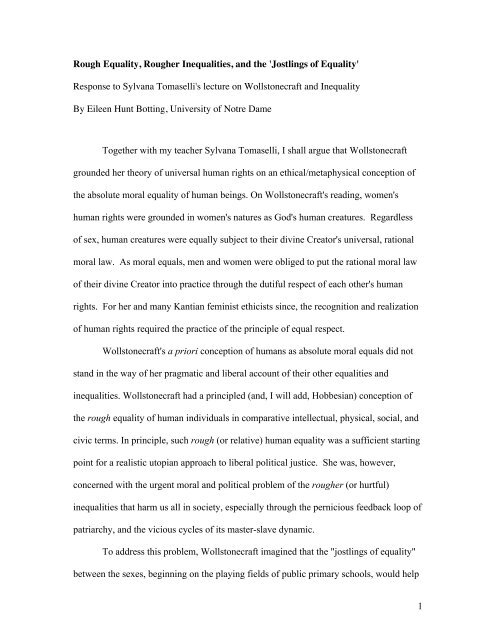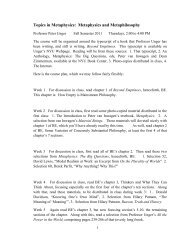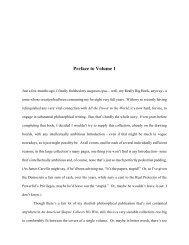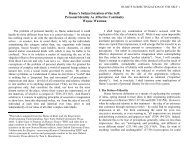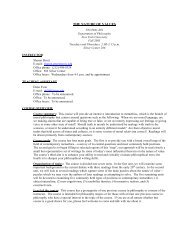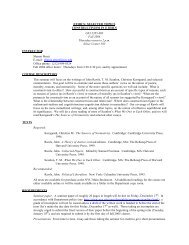1 Rough Equality, Rougher Inequalities, and the 'Jostlings of ...
1 Rough Equality, Rougher Inequalities, and the 'Jostlings of ...
1 Rough Equality, Rougher Inequalities, and the 'Jostlings of ...
You also want an ePaper? Increase the reach of your titles
YUMPU automatically turns print PDFs into web optimized ePapers that Google loves.
<strong>Rough</strong> <strong>Equality</strong>, <strong>Rough</strong>er <strong>Inequalities</strong>, <strong>and</strong> <strong>the</strong> <strong>'Jostlings</strong> <strong>of</strong> <strong>Equality</strong>'Response to Sylvana Tomaselli's lecture on Wollstonecraft <strong>and</strong> InequalityBy Eileen Hunt Botting, University <strong>of</strong> Notre DameToge<strong>the</strong>r with my teacher Sylvana Tomaselli, I shall argue that Wollstonecraftgrounded her <strong>the</strong>ory <strong>of</strong> universal human rights on an ethical/metaphysical conception <strong>of</strong><strong>the</strong> absolute moral equality <strong>of</strong> human beings. On Wollstonecraft's reading, women'shuman rights were grounded in women's natures as God's human creatures. Regardless<strong>of</strong> sex, human creatures were equally subject to <strong>the</strong>ir divine Creator's universal, rationalmoral law. As moral equals, men <strong>and</strong> women were obliged to put <strong>the</strong> rational moral law<strong>of</strong> <strong>the</strong>ir divine Creator into practice through <strong>the</strong> dutiful respect <strong>of</strong> each o<strong>the</strong>r's humanrights. For her <strong>and</strong> many Kantian feminist ethicists since, <strong>the</strong> recognition <strong>and</strong> realization<strong>of</strong> human rights required <strong>the</strong> practice <strong>of</strong> <strong>the</strong> principle <strong>of</strong> equal respect.Wollstonecraft's a priori conception <strong>of</strong> humans as absolute moral equals did notst<strong>and</strong> in <strong>the</strong> way <strong>of</strong> her pragmatic <strong>and</strong> liberal account <strong>of</strong> <strong>the</strong>ir o<strong>the</strong>r equalities <strong>and</strong>inequalities. Wollstonecraft had a principled (<strong>and</strong>, I will add, Hobbesian) conception <strong>of</strong><strong>the</strong> rough equality <strong>of</strong> human individuals in comparative intellectual, physical, social, <strong>and</strong>civic terms. In principle, such rough (or relative) human equality was a sufficient startingpoint for a realistic utopian approach to liberal political justice. She was, however,concerned with <strong>the</strong> urgent moral <strong>and</strong> political problem <strong>of</strong> <strong>the</strong> rougher (or hurtful)inequalities that harm us all in society, especially through <strong>the</strong> pernicious feedback loop <strong>of</strong>patriarchy, <strong>and</strong> <strong>the</strong> vicious cycles <strong>of</strong> its master-slave dynamic.To address this problem, Wollstonecraft imagined that <strong>the</strong> "jostlings <strong>of</strong> equality"between <strong>the</strong> sexes, beginning on <strong>the</strong> playing fields <strong>of</strong> public primary schools, would help1
to counteract over time men's <strong>and</strong> women's adaptation to pernicious gender norms inlove, family, <strong>and</strong> society at large. Such deep, egalitarian reforms in education wouldgradually trigger a paradigm shift in <strong>the</strong> way that men <strong>and</strong> women saw <strong>and</strong> treated eacho<strong>the</strong>r. As lifelong friends who had roughhoused on <strong>the</strong> playground according to <strong>the</strong> samerules, adult men <strong>and</strong> women would be psychologically primed to put into practice <strong>the</strong>moral principle <strong>of</strong> equal respect. Given <strong>the</strong> political advances in <strong>the</strong> legal recognition <strong>of</strong><strong>the</strong> natural rights <strong>of</strong> humans during <strong>the</strong> American <strong>and</strong> French revolutions, Wollstonecraftharbored a reasonable hope that equally educated adults could learn to work in t<strong>and</strong>em toinstitutionalize human rights in law <strong>and</strong> culture. Taking <strong>the</strong> long view, she posited equalpublic education as <strong>the</strong> means by which <strong>the</strong> principle <strong>of</strong> equal respect would become <strong>the</strong>basis for institutionalizing <strong>the</strong> rough equality <strong>of</strong> humans, <strong>the</strong>reby remedying, over time,<strong>the</strong>ir rougher <strong>and</strong> arbitrary experiences <strong>of</strong> inequality.So, yes, I agree with Tomaselli that Wollstonecraft began <strong>the</strong> non-ideal dimension<strong>of</strong> her political <strong>the</strong>ory with <strong>the</strong> fact <strong>of</strong> human inequality. To paraphrase her interlocutorRousseau, she began with women as <strong>the</strong>y are, to <strong>the</strong>orize what <strong>the</strong>y might become. But itwas in <strong>the</strong> practical yet principled spirit <strong>of</strong> Hobbes that she did so. Humans were notequal in practice, nor would <strong>the</strong>y ever fully be so. But <strong>the</strong>y were equal enough: all thingsconsidered, <strong>the</strong>y were roughly equal. A smart woman could outwit a dumb man, <strong>and</strong> astrong man could dominate a weak woman, any day...or night. It all evened out, whenyou looked at human capabilities from a comparative perspective.Yet, like John Stuart Mill after her, Wollstonecraft allowed <strong>the</strong> possibility thatgirls <strong>and</strong> women might, over time, through greater opportunities in physical education<strong>and</strong> health care, develop <strong>the</strong>mselves to achieve <strong>the</strong> same or greater physical strength as2
oys <strong>and</strong> men. This Amazonian outcome was <strong>of</strong> course Rousseau's greatest nightmare, ormost cherished sexual fantasy (I'm not sure which). Unlike Rousseau, Wollstonecraft didnot fear this potential outcome <strong>of</strong> equal education. She didn't even care so much about<strong>the</strong> achievement <strong>of</strong> a perfect equality between <strong>the</strong> sexes (in strength, in intellect, or inwealth), as much as she cared about <strong>the</strong> establishment <strong>of</strong> a perfectly equal st<strong>and</strong>ard <strong>of</strong>morality in law <strong>and</strong> culture. As much as she thought it would be best to mitigate <strong>the</strong>inequalities <strong>of</strong> class among people, she did not think it was morally necessary (orpolitically realistic) to eliminate all forms <strong>of</strong> inequality from economics, as long aspeople practiced charity <strong>and</strong> governments provided equal rights to rich <strong>and</strong> poor alike.Her absolute st<strong>and</strong>ard <strong>of</strong> moral equality, which dem<strong>and</strong>ed <strong>the</strong> elimination <strong>of</strong>double st<strong>and</strong>ards in law, religion, <strong>and</strong> culture, derived from her moral perfectionism. Herontology <strong>of</strong> <strong>the</strong> human being is <strong>the</strong> starting point for her perfectionistic account <strong>of</strong> hum<strong>and</strong>evelopment, which underst<strong>and</strong>s <strong>the</strong> ultimate purpose <strong>of</strong> human life as <strong>the</strong> learning <strong>and</strong>practice <strong>of</strong> moral virtue in social relationships. Although she was not a perfectionist whenit came to establishing human equality in society, she was a perfectionist when it came todefining human morality <strong>and</strong> how its universal principles ought to be realized in society.Her justification <strong>of</strong> universal human rights was an expression <strong>of</strong> her moral universalism<strong>and</strong> moral perfectionism. The establishment <strong>of</strong> a universal human rights st<strong>and</strong>ard in lawwas one important practical step toward enabling a rough equality to flourish in factamong humans. This universalistic moral st<strong>and</strong>ard dem<strong>and</strong>ed <strong>the</strong> abolition <strong>of</strong> slavery,coverture, <strong>and</strong> <strong>the</strong> aristocratic class system, as a prelude to <strong>the</strong> establishment <strong>of</strong> equal"civil <strong>and</strong> political rights" for all adults in a representative republic. These sweeping3
legal reforms would mitigate <strong>the</strong> pernicious influence <strong>of</strong> <strong>the</strong> rougher, hurtful, man-madeinequalities that precluded <strong>the</strong> perfectionistic moral development <strong>of</strong> humanity.For Wollstonecraft, friendship ought to function as a symbiotic relationshipwithin which moral equals inspire each o<strong>the</strong>r to strive for moral perfection. For example,boys <strong>and</strong> girls who played <strong>the</strong> same games toge<strong>the</strong>r would inspire each o<strong>the</strong>r to practice<strong>the</strong> same virtues, such as respectful competition <strong>and</strong> amiableness. Despite this egalitarianideal <strong>of</strong> higher friendship, she acknowledged that it was certainly possible, evenprobable, that one would gravely misjudge one's friends <strong>and</strong> <strong>the</strong>ir intentions. Her first,un<strong>of</strong>ficial, husb<strong>and</strong>, Gilbert Imlay, was a case in point. Despite her loving him as hereternal spiritual partner, he turned out to be a cad: a man who cared more for mere"commerce" (in economic <strong>and</strong> sexual traffic) than for <strong>the</strong> needs <strong>of</strong> <strong>the</strong> mo<strong>the</strong>r <strong>of</strong> hisinfant daughter <strong>and</strong> <strong>the</strong>ir future as a family. But Wollstonecraft had o<strong>the</strong>r, dear friends inher life, including her only true (<strong>and</strong> legal) husb<strong>and</strong>, William Godwin, who showed herano<strong>the</strong>r way.Wollstonecraft's philosophy <strong>of</strong> higher friendship has both Aristotelian <strong>and</strong>Kantian dimensions. Yet she moves beyond each <strong>of</strong> <strong>the</strong>se philosophical models <strong>of</strong> interrelationalequality by emphasizing <strong>the</strong> redemptive power <strong>of</strong> higher friendship for <strong>and</strong>among people beyond elite men. Wollstonecraft democratizes higher friendship byaccommodating a place for everyone within it. Everyone could <strong>and</strong> should inspiresomeone else to <strong>the</strong> higher virtues through friendship: spouses, peers, siblings, parents, aswell as parents <strong>and</strong> <strong>the</strong>ir children.One <strong>of</strong> <strong>the</strong> most redemptive forms <strong>of</strong> friendship could be between women <strong>of</strong>different classes. In her final novel, Maria, or <strong>the</strong> Wrongs <strong>of</strong> Woman, Wollstonecraft4
for <strong>the</strong>y all struggled in some terrible way with <strong>the</strong> grim realities <strong>of</strong> patriarchy. Byspeaking in <strong>the</strong> collective <strong>and</strong> critical voice <strong>of</strong> her friends, family, <strong>and</strong> fellow women,Wollstonecraft acts as a political prophet for <strong>the</strong> human status <strong>and</strong> human rights <strong>of</strong> "<strong>the</strong>oppressed half <strong>of</strong> <strong>the</strong> human species". She clears a way in <strong>the</strong> wilderness for women torethink <strong>the</strong>ir pernicious relationships with one ano<strong>the</strong>r, so that future generations <strong>of</strong> girlsmight grow up to see each o<strong>the</strong>r more as genuine friends <strong>and</strong> less as punishing rivals.Through such amiable relationships, girls might grow up to respect not only o<strong>the</strong>rs but,first <strong>and</strong> foremost, <strong>the</strong>mselves.Wollstonecraft wrote in her Rights <strong>of</strong> Woman that any woman deserves <strong>the</strong> choice<strong>of</strong> a "single life with dignity" instead <strong>of</strong> marriage. While she was a 32-year-old virginwhen she made this case, her defense <strong>of</strong> <strong>the</strong> "single life with dignity" is not necessarilysmall-p puritan or asexual in moral import. Most <strong>of</strong> her arguments about <strong>the</strong> dangers <strong>of</strong>sex for women have to do with <strong>the</strong> all-too-real eighteenth-century problems <strong>of</strong>prostitution, marital infidelity, venereal disease, marital rape, involuntary mo<strong>the</strong>rhood,<strong>and</strong> death from miscarriage <strong>and</strong> childbirth. Similarly to <strong>the</strong> Kantian feminist ethicistLara Denis, she thought <strong>the</strong> principle <strong>of</strong> equal respect required that marriage should be arespectful friendship in which sex was never exploitative but ra<strong>the</strong>r reflective <strong>of</strong> mutuallove. This is one reason why Wollstonecraft favored marital pairs over polygamy.Marriage primarily ought to be a relationship between "equal moral beings," <strong>and</strong>secondarily a relationship that concerned natural functions such as sexual reproduction.Polygamy or poly<strong>and</strong>ry might be permissible if marriage was meant to be like a businessor corporate contract, in which maximum productivity for <strong>the</strong> group was <strong>the</strong> goal.Despite <strong>the</strong> Kantian limits she laid down for ethical sexual behavior, Wollstonecraft6
thought <strong>the</strong>re was nothing intrinsically wrong with sex or having a female body. Whileher Rights <strong>of</strong> Woman issued some warnings about <strong>the</strong> dangerous moral <strong>and</strong> physicalconsequences <strong>of</strong> pre-marital (hetero- or homo-) sexual behavior, especially for childrenor early adolescents, she had a generous view <strong>of</strong> <strong>the</strong> gender roles we might play insociety. For example, she praised <strong>the</strong> famous French transvestite <strong>and</strong> diplomat, CharlesD'Eon, as a woman who "acquired courage <strong>and</strong> resolution" from "from having received amasculine education."Wollstonecraft <strong>of</strong>ten spoke <strong>of</strong> <strong>the</strong> "sober pleasures" <strong>of</strong> rational thought <strong>and</strong>philosophy, while always insisting that <strong>the</strong>se pleasures suited <strong>the</strong> sexless minds <strong>of</strong> men<strong>and</strong> women alike. Unlike Kant, who has been criticized by feminist philosophers forpositing an "idealized" conception <strong>of</strong> a rational male agent at <strong>the</strong> core <strong>of</strong> his ethical<strong>the</strong>ory, Wollstonecraft's approach to ethics resists such a built-in sex bias. Herphilosophical anthropology <strong>of</strong> human beings specifically accounts for biological sexdifferences across <strong>the</strong> species. She proceeded from <strong>the</strong> naturalistic fact <strong>of</strong> femaleembodiment in her <strong>the</strong>ory <strong>of</strong> <strong>the</strong> girl-child's human development.Like Martha Nussbaum, Wollstonecraft also had a capacious underst<strong>and</strong>ing <strong>of</strong> <strong>the</strong>variety <strong>of</strong> capabilities that define <strong>the</strong> human experience, such as sympathy, love, play,<strong>and</strong> bodily integrity. This rich view <strong>of</strong> <strong>the</strong> physical joys <strong>and</strong> freedoms <strong>of</strong> embodiedhuman life was captured in her Rousseau-inspired account <strong>of</strong> child development: "Everyyoung creature requires almost continual exercise, <strong>and</strong> <strong>the</strong> infancy <strong>of</strong> children...should bepassed in harmless gambols, that exercise <strong>the</strong> feet <strong>and</strong> h<strong>and</strong>s." Although she was morelike Kant in her deontological <strong>the</strong>ory <strong>of</strong> <strong>the</strong> foundations <strong>of</strong> human rights, Wollstonecraftparallels many <strong>of</strong> Nussbaum's views on <strong>the</strong> moral importance <strong>of</strong> conceptualizing humans7
in a holistic way that captures <strong>the</strong> affective richness <strong>of</strong> <strong>the</strong>ir ethical <strong>and</strong> political lives.Reason has priority in Wollstonecraft's ethics but it is not exclusive <strong>of</strong> o<strong>the</strong>r human traitssuch as passion. As Amartya Sen has noted, one <strong>of</strong> Wollstonecraft's great contributions topolitical philosophy is her modeling <strong>of</strong> rational yet wrathful argument, spurred by moraloutrage at wrongs done to oneself <strong>and</strong> o<strong>the</strong>rs, in "loudly" dem<strong>and</strong>ing "JUSTICE for onehalf <strong>of</strong> <strong>the</strong> human race."While Tomaselli has accurately placed Wollstonecraft within <strong>the</strong> sometimeslower-case "spartan" republican discourse <strong>of</strong> <strong>the</strong> late eighteenth century, her rights-based,representative republicanism is both too pacifist <strong>and</strong> too liberal to be upper-case"Spartan". Wollstonecraft was not so much spartan as A<strong>the</strong>nian, just as she was not somuch puritan as she was a rational Christian Dissenter in <strong>the</strong> school <strong>of</strong> <strong>the</strong> ReverendRichard Price. She was a radical advocate <strong>of</strong> <strong>the</strong> Socratic method in primary education.Like her contemporary <strong>and</strong> fellow Englishwoman Jane Austen, her Christian feminismled her to appropriate Aristotelian ethics. For Wollstonecraft, modesty was not <strong>the</strong>conventional feminine virtue <strong>of</strong> coquettish sexual self-restraint, but ra<strong>the</strong>r a universalhuman virtue <strong>of</strong> sober-self-judgment. Modesty was a mean between <strong>the</strong> extremes <strong>of</strong>misguided confidence <strong>and</strong> excessive humility. Perhaps this is why many people readAusten's smart yet amiable Elizabeth Bennett as <strong>the</strong> Wollstonecraftian heroine <strong>of</strong> Pride<strong>and</strong> Prejudice.As Tomaselli insightfully explores, <strong>the</strong> intellectual influence <strong>of</strong> Plato <strong>and</strong>Christian Platonism runs deep in Wollstonecraft's philosophy <strong>of</strong> love <strong>and</strong> education. Iread Wollstonecraft's Platonic model for education to be <strong>the</strong> female philosopher Diotima,who points <strong>the</strong> way for <strong>the</strong> young Socrates to climb upward to <strong>the</strong> "sea <strong>of</strong> beauty" <strong>and</strong>8
truth. For me, Wollstonecraft's debt to <strong>the</strong> Symposium shines most clearly through herLetters Written during a Short Residence in Sweden, Norway, <strong>and</strong> Denmark. Thiscourageous autobiographical reflection on her struggle to move past her unrequited lovefor Imlay was a record <strong>of</strong> her psychological return to a "single life with dignity".Wollstonecraft thought we ought to strive to transcend <strong>the</strong> rougher inequalities in love.For her, we climb Diotima's philosophical ladder to rise to <strong>the</strong> level <strong>of</strong> <strong>the</strong> sea <strong>of</strong> beauty,not to reject love itself, but ra<strong>the</strong>r to comprehend <strong>the</strong> beauty <strong>of</strong> <strong>the</strong> knowledge gained by<strong>the</strong> rougher struggles <strong>of</strong> loving.For Wollstonecraft, our modern Diotima, this ladder climb to self-knowledgebegins with <strong>the</strong> "jostlings <strong>of</strong> equality," <strong>the</strong> rough-<strong>and</strong>-tumble play which we experienceon <strong>the</strong> horizontal playing fields <strong>and</strong> equal starting lines <strong>of</strong> primary education. In herpractical philosophy <strong>of</strong> education, Wollstonecraft's moral perfectionism meets herpolitical egalitarianism. She envisioned universal primary education as operatingaccording to three core moral principles that would toge<strong>the</strong>r undermine <strong>the</strong> rougherinequalities by instilling an egalitarian ethic <strong>of</strong> mutual respect among children. Theseprinciples are universalistic holism, dutiful individualism, <strong>and</strong>, most vitally,psychological optimism in <strong>the</strong> human capability for positive development. Applied inconcert in a "national system" <strong>of</strong> free, m<strong>and</strong>atory, public, coeducational, primary dayschools, <strong>the</strong>se three principles would enable children to eschew <strong>the</strong> damaging genderstereotypes that <strong>the</strong>ir culture had afforded <strong>the</strong>m.Her universalistic holism entailed an education that developed, ra<strong>the</strong>r than"stunted," <strong>the</strong> potential <strong>of</strong> <strong>the</strong> "body, heart, <strong>and</strong> underst<strong>and</strong>ing." By playing toge<strong>the</strong>rduring hourly recess in <strong>the</strong> grounds surrounding <strong>the</strong> school, girls <strong>and</strong> boys would learn to9
see <strong>and</strong> treat each o<strong>the</strong>r as embodied human equals. Differences in body or sex did nottranslate into differences in moral status or rules. The only rule specified for <strong>the</strong>ircoeducational outdoor play ought to be "national" in scope: <strong>the</strong> general prohibition <strong>of</strong>brutality toward animals. Unlike Kant's rule against animal cruelty, this prohibition wasfor <strong>the</strong> moral <strong>and</strong> physical benefit <strong>of</strong> humans <strong>and</strong> animals, not solely for <strong>the</strong> moralrectitude <strong>of</strong> humans. By learning to treat animals benevolently in <strong>the</strong>ir games, childrenwould discern <strong>the</strong> Rousseauian idea that all embodied, sentient creatures (includinghumans) had natural rights to respect <strong>of</strong> <strong>the</strong>ir bodily integrity. Finally, holism dem<strong>and</strong>edday schools because children needed <strong>the</strong>ir families for a complete moral education.Dutiful individualism was not about inculcating a sense <strong>of</strong> social isolation butra<strong>the</strong>r a sense <strong>of</strong> moral responsibility to oneself <strong>and</strong> o<strong>the</strong>rs. Integrating boys <strong>and</strong> girls <strong>of</strong>different class backgrounds was <strong>the</strong> key to <strong>the</strong> deeper psychological transformation <strong>of</strong><strong>the</strong>ir images <strong>of</strong> <strong>the</strong>mselves <strong>and</strong> each o<strong>the</strong>r. As she wrote in <strong>the</strong> Rights <strong>of</strong> Woman, "<strong>the</strong>yshould be sent to school to mix with a number <strong>of</strong> equals, for only by <strong>the</strong> jostlings <strong>of</strong>equality can be formed a just opinion <strong>of</strong> ourselves."Optimism, or a belief in one's capability for positive development, would beinculcated through a st<strong>and</strong>ard yet stimulating curriculum. Girls <strong>and</strong> boys would be taughtbotany, mechanics, astronomy, reading, writing, arithmetic, natural history, <strong>and</strong> simpleexperiments in natural science, but such intellectual training would "never encroach ongymnastic plays in <strong>the</strong> open air." In Socratic conversation with <strong>the</strong>ir teachers, <strong>the</strong>y wouldlearn elements <strong>of</strong> religion, history, anthropology, <strong>and</strong> politics. In this way, optimisticteaching methods <strong>and</strong> goals reinforced <strong>the</strong> holistic dimension <strong>of</strong> universal primaryeducation.10
Nearly two centuries later, <strong>the</strong> 1989 United Nations Convention <strong>the</strong> Rights <strong>of</strong> <strong>the</strong>Child similarly recognized free primary education, including physical education, as auniversal human right <strong>of</strong> children. Remarkably, Wollstonecraft's plan for "nationaleducation" overlaps with <strong>the</strong> contemporary definition <strong>of</strong> universal primary educationused by <strong>the</strong> United Nations: enabling all children, boys <strong>and</strong> girls, to complete educationfrom grades one through five. In 2012, <strong>the</strong> United Nations has reported significantprogress in realizing gender equity in primary education in developing countries, yet "tenmillion more girls than boys" remain out <strong>of</strong> primary school <strong>and</strong> "nearly two-thirds <strong>of</strong> <strong>the</strong>world's 780 million people who cannot read are women." Alongside Kant's 1795argument for a peaceful world federation <strong>of</strong> rights-based republics, Wollstonecraft's 1792dem<strong>and</strong> for a universal human right to primary education remains farsighted in both<strong>the</strong>ory <strong>and</strong> practice. Her arguments for <strong>the</strong> egalitarian transformation <strong>of</strong> <strong>the</strong> family,friendship, <strong>and</strong> primary education, combined with her philosophy <strong>of</strong> universal humanrights, make her <strong>the</strong> most consistent defender <strong>of</strong> <strong>the</strong> ideal <strong>of</strong> political equality during <strong>the</strong>Enlightenment.11


